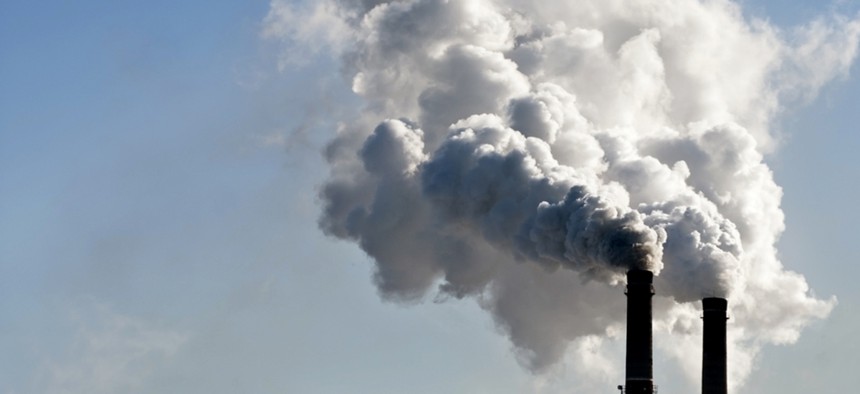
Andriano/Shutterstock.com
Obama Plan Brings Back Carbon Tax Conversation
Sweeping power-plant regulations would enable states to use pollution trading, fees to cut heat-trapping emissions
The big national cap-and-trade plan died on Capitol Hill five years ago, and it remains very much dead. A carbon tax—the perennial academic solution for curbing greenhouse-gas emissions—had even less traction in Congress and lives on mostly in think tanks.
But President Obama's Environmental Protection Agency climate regulations for power plants, unveiled on Monday, may give those policies new life at the state level.
In a change from the draft plan, the final EPA rule now explicitly says states can use "fees" (i.e., taxes) as a tool for meeting their emissions-cutting requirements. That's on page 899 of the massive 1,560-page rule. Plans that states craft to comply with the mandate, the rule states, "could accommodate imposition by a state of a fee for CO2 emissions from affected [electric generating units], an approach suggested by a number of commenters."
That language is a rather brief blessing but enough to excite the ad-hoc, Left-Right mix of environmentalists, economists, and a few conservative carbon-tax advocates who have long been swimming upstream at the national and state level.
David Bookbinder, a former high-level Sierra Club lawyer, says carbon-tax backers will immediately begin fresh discussions about how they can convince states to get on board. "We have all been waiting for this," said Bookbinder, now an adjunct scholar at a think tank called the Niskanen Center. "The calls will probably start tonight or tomorrow."
"The next step is to ensure that states know about this option and consider it seriously," said Brookings Institution economist Adele Morris, who has long argued that EPA should let states use taxes to meet the power-plant mandates.
Morris said she's "delighted" by the new rule language.
"This is great news for states that want to pursue a cost-effective, easily-administered, market-based approach," Morris said. "States can not only comply with the new rule, they can also solve fiscal shortfalls and accomplish pro-growth tax reform."
Carbon taxes don't guarantee emissions cuts, however, so it's among the state measures that would require a "backstop" of "federally enforceable emission standards" in case they don't bring about the mandated reductions.
While the rule very briefly blesses carbon taxes as an option, experts predict that another form of putting a price on carbon emissions—the trading of pollution credits or allowances—is more likely to gain steam under EPA's rule. The Clean Power Plan provides detailed discussions of how states can use emissions-trading systems to comply with the rules, which are aimed at cutting power-plant emissions 32 percent overall by 2030.
The plan also describes how states can make their power plants "trading ready," which allows them to participate in trading with plants in other states even in the absence of formal interstate pacts.
EPA's promotional materials on the rule call trading "cost-effective," and the agency is vowing to support states' efforts on tracking emissions and emissions credits in order to help implement multistate trading.
"Clearly EPA is doing what they can to make it easy for states to opt for emissions trading," said Kevin Kennedy, a climate expert with the World Resources Institute.
The rule could substantially expand use of market-based trading systems beyond what's in place in California and the Regional Greenhouse Gas Initiative, a consortium of Northeastern states with a regional cap-and-trade system for power plants.
"I think we can expect development of more markets around the country," said Anthony Paul of the environmental think tank Resources For the Future, who predicts that "many more" states will adopt carbon-pricing policies. "We could see rather large markets that involve many states under the Clean Power Plan."
To be sure, Republicans turned against cap-and-trade years ago, even though it was once favored among many conservatives as a way to cut pollution using markets to steer the most cost-effective and efficient emissions curbs.
But now that EPA has finalized the rules, Paul predicts that trading could find favor in states with GOP leaders. "The advantages of market-based regulations are many, and I think even in Republican states it will be hard to ignore those advantages," he said.
Bookbinder notes that Clean Air Act rules are the only tool available to cut power-plant emissions, but says the ambitious but complex rules will bring years of legal challenges.
He argues that a federal, "revenue-neutral" carbon tax is a better approach, and believes that if some states adopt taxes to comply with Obama's rules, it could make Congress more open to the idea.
"It's the most economically efficient way of reducing emissions. ... If we can get states to do this, it will give Congress some comfort that it can be done in a bipartisan manner," Bookbinder said, arguing that there are openings for carbon taxes in states with divided government, such as Illinois.
Morris, for her part, says tax backers need to make their case to states.
"When the dust settles, I think states will come to see this as a very viable option. For advocates of taxing carbon, EPA's final rule is a threshold achievement," she said. "The next step is to ensure that states know about this option and consider it seriously."
(Image via Andriano/Shutterstock.com)







